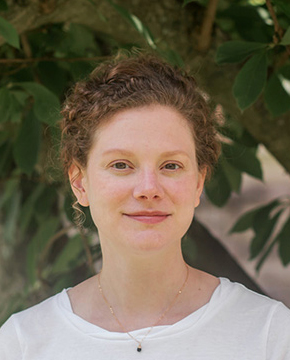
If you’ve ever tried petting a dog tail to head instead of vice versa, you’re acutely aware of the fact that fur has directionality. As common as this is, the process by which the cells of a developing embryo create this phenomenon is far from mundane. And the implications are far more significant than whether you ruffle your dog’s fur. Errors in the system that determines directional alignment during development can cause devastating dysfunction in neural tube closure, body elongation, and heart development.
Genetics, Cell Biology, and Development assistant professor Maureen Cetera is working to understand how cells in a developing organism figure out which end is which and coordinate with each other across relatively large distances. To do so, she’s taking a deep dive into how directionality is communicated in what is the largest and most accessible organ for many animals – the skin.
We already know that cell membrane proteins from the planar cell polarity (PCP) pathway provide directional signals by clustering on one side of the cell – and when they do, the proteins in neighboring cells follow suit. But how does that directionality align across larger distances? “There’s some sort of factor that is coordinating the axis of polarity within each cell with the body axis,” Cetera says. “The fundamental question is how these two axes are coupled.”
Cetera has developed methods that make it possible to live-track cellular and tissue-level activity at the same time. These tools have enabled Cetera to discover that in mouse skin, PCP orchestrates hair orientation by causing cells to flow in one direction during development. Moreover, She has discovered mutations that cause follicles to orient differently without altering other aspects of development– think of the patch of wayward fur on a Rhodesian ridgeback – a likely result of a long-distance communication breakdown on directionality. How this long distance communication occurs is a current focus of Cetera’s research.
To find out, Cetera is investigating changes in gene expression across the skin and mapping spontaneous mutations that disrupt fur orientation in fancy show mice and guinea pigs.
What she discerns could offer valuable clues to the genetic basis of directionality over distance – including how decoupling large-scale cues allow local directional variation without disrupting directionality critical for proper organ development.
Eventually, Cetera hopes to uncover broader lessons for developmental biology.
“In the skin we can uncouple those two things—spontaneous mutations can alter the direction of the hair follicle but doesn’t affect the development of the rest of the organism. So we think genes that link the PCP axis with the body axis evolved to take on different functions. If we can figure out how the pathways are connected in the skin, we can go back into other, more complex processes such as neural tube closure and heart development to see if they interact in the same way.”
— Mary Hoff